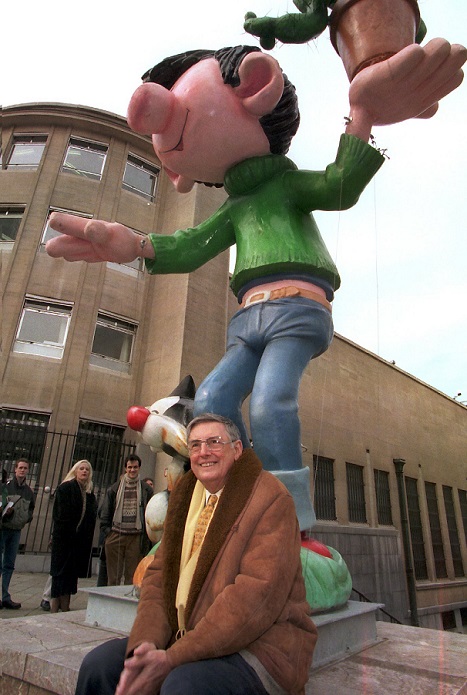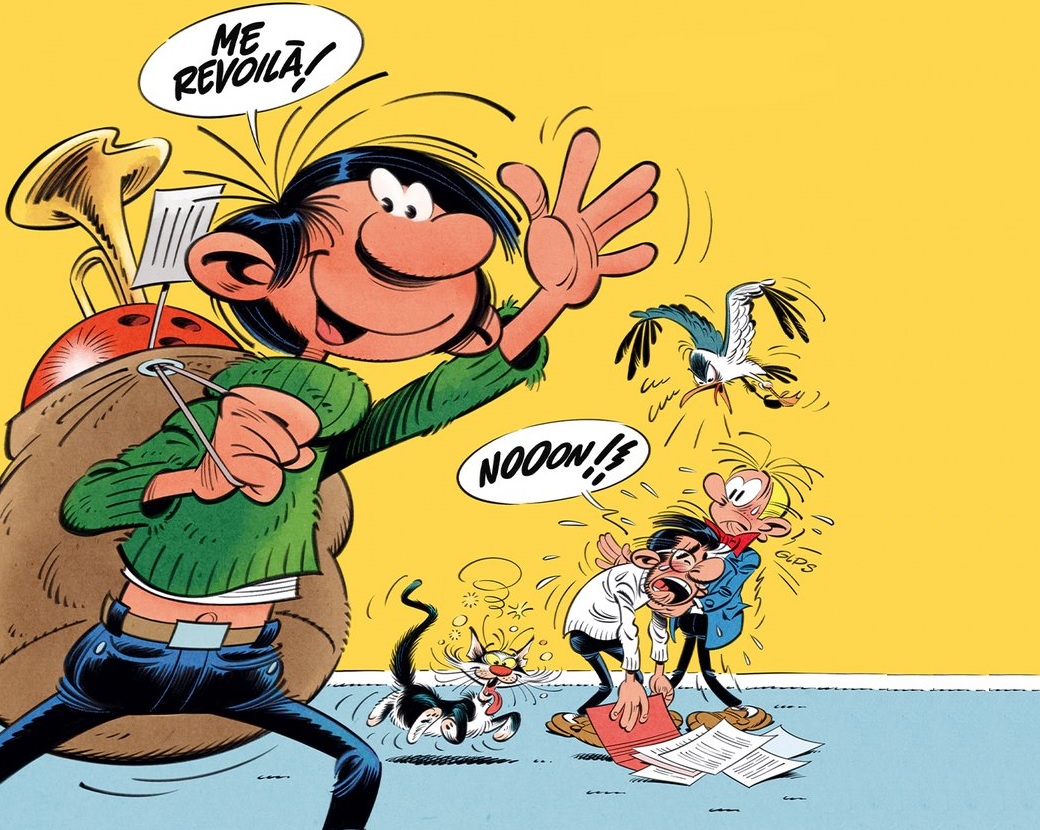Since everything needs a beginning, let's rewind and start the story in the middle of the Second World War.
We are in Brussels, where, despite the shock of the occupation, a few teenagers are sharing their passion for comics, cartoons and caricatures. Among them are André Franquin, Maurice (later known as Morris) De Bevere and Edouard (Eddy) Paape. They are talking about what will be known as bande dessinée, or comic strips. And they have a clear penchant for American comics and the Disney style – hence the anglicisation of Morris and Eddy Paape's first names.
This pits them against their elders. Hergé, the creator of Tintin, and Joseph Gillain (Jijé) have a more homegrown style: more realistic, less rubbery, and redolent of the old Europe cartoonists like Benjamin Rabier and Rodolphe Töpffer.
In those troubled times, neither cartoons nor American comics reached Belgium, so these teenagers had to produce locally. The group of friends founded a small cartoon studio in Brussels in 1944 and included a young artist Pierre Culliford, nicknamed Peyo.
The studio went bankrupt after a year. But the merry band was approached by the Dupuis publishing house in 1945 to fill the pages of Spirou, the weekly magazine for youngsters published in Marcinelle, near Charleroi. It would eventually become known as the Marcinelle School of bande dessinée, but no-one ever used that term, especially since most of them were not really from the region. And it was mainly Jijé who filled the magazine.
The younger artists introduced him to American styles and helped him by taking over the series he created: Eddy Paape continued with Jean Valhardi, Will (Willy Maltaite) picked up Tif and Tondu, and Franquin took on the flagship Spirou and Fantasio series.
Franquin, Morris, and the young Will would spend their days with Jijé's family in Waterloo, filling the magazine and infecting each other with their enthusiasm. Morris launched Lucky Luke and Franquin stepped up, allowing Jijé to produce drawn biographies of Don Bosco, Robert Baden-Powell and even Jesus.
Sometime later, Franquin found Peyo and recommended him to Dupuis, which published Johan and Pirlouit, the series from which the Smurfs emerged. Jijé would help them practice their craft from life and perfect their artistic style. They also refined what will be called, and not always in flattering terms, the “big nose” style.
In 1948, fearing a Third World War in Europe, Jijé left for the United States, taking not only his family but also Franquin and Morris. It was in New York that Morris met René Goscinny, long before the latter created Asterix with Uderzo.
It is perhaps thanks to this stay in New York, and to his meeting with Mad magazine editor Harvey Kurtzman, that Goscinny brought a parodic and gently mocking spirit back to France, where Asterix was launched in Pilote magazine.
Sneers and jeers
For years, the authors of comics were sneered at. "So, you make 'little mickeys' like that? It's a job? How do you feed your family?" they said. At first, comic strips were only intended to appear in weekly serials. However, years of frustration were swept away by the arrival of albums that nurture the collecting instincts of readers. Commercial success followed, and by the 1950s, comics were finally taken seriously.
It should be said that the writers and artists did not take themselves seriously. What was later called the Marcinelle School was very different to the Brussels School (ligne claire, or clear line). If any of the artists began to show off in one way or another, he became an object of ridicule for his colleagues. There was humility and self-mockery.
This lampooning was mainly thanks to Yvan Delporte, the editor-in-chief of Spirou from 1955 to 1968. An eccentric character (for two years, he took care of a lion cub in the centre of Brussels), highly cultured, very fond of absurd humour and passionate about Anglo-Saxon magazines, Delporte was the detonator for many creations in the Marcinelle School. His magazine was packed with surprising, wacky ideas, and as soon as an author came up with an amusing notion (the Smurfs, Gaston Lagaffe), Delporte would bounce with gusto.
Franquin, first among equals
André Franquin, who was born in Etterbeek 100 years ago next January, was the primus inter pares. It was Delporte who would declare: “Franquin KNOWS that he draws badly!" Even if he always claimed the opposite, Franquin was seen as infinitely more gifted than his colleagues and a model for the whole profession.

Franquin with the statue of Gaston Lagaffe in Brussels
His approach to cartooning always began with lots of realistic drawings from nature. He never stopped looking for new techniques, so he could keep replenishing his passion for drawing. Franquin couldn't say no. In addition to comics, he also drew newspaper caricatures.
In 1968, Franquin dropped Spirou, tired of working on a character that did not belong to him. Instead, he devoted himself full-time to his baby: Gaston Lagaffe. Created in 1957, enthusiastically backed by Delporte, Gaston was a character who supposedly arrived at the Spirou editorial office as a stopgap, before becoming the prototype of the office clown. Although not premeditated, this universal blunderer became an icon for readers.
Gaston Lagaffe was distinguished not only by its exceptional graphic style, which develops over the eras he goes through – but also from its extraordinary reflection on these eras. An oddball in a turtleneck sweater, blue jeans and espadrilles, slightly beatnik at first, he became almost hippie then eco-friendly. He shook up the established system despite himself.
In 1976, Franquin tried something darker, after feeling the urge to "dip Gaston in soot". He produced a series of silhouette boards, using an ultra-fine Indian ink pen, called Les Idées Noires. It became his masterpiece. Initially published in Le Trombone Illustré, a supplement to Spirou, Les Idées Noires continued in Marcel Gotlib's French monthly: Fluid Glaciale.
France catches up
What was once called the Marcinelle School brought together this group of friends, to which we can add Roba, Tillieux, Jidéhem, Hubinon, Lambil, Sirius, Remacle, Rosy, Deliège and many others.
But by the start of the 1970s, Belgian comics had lost some lustre and looked outdated compared to their French counterparts. In France artists including Fred, Tardi, Bilal, F'Murrr experimented with more varied graphics. However, artists like Uderzo, Jean Giraud (Gir) or Mézières, all pupils of Jijé, were part of what they considered the Franco-Belgian school.
Franquin was one of the few who did not want to give up the chase and be relegated to the previous generation of dad's comics. When he was tired of a technique, he would research other graphic ideas (monsters, doodles, Tifous, etc). Meanwhile, publisher Charles Dupuis asked other young authors and artists to imitate Franquin's method. It wasn't his best idea: the next generation struggled to find their own graphic identity. They never lived up to Franquin's standards.
Perhaps like the Beatles, who were directly inspired by the US and symbolised a new approach to popular music, these little Belgians, led by Franquin, created their own popular graphic style, which owes a lot to Disney. And even now, we can still link the Marcinelle School from the post-war period to the 1980s and to the current crop. Franquin, who died in 1997, leaves a copious, fascinating and important body of work, and he continues to influence comic book authors and artists today.

